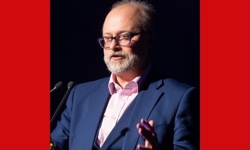Neil Benson, the editorial director at Trinity Mirror Regionals, chose a brilliant cartoon by Steve Best to illustrate the digital path he was forging for his local newspapers.
It depicts the Bible story about Moses crossing the Red Sea, which God miraculously parted to enable the Israelites to flee the Egyptians. But Moses is shown to be frustrated at his followers’ reluctance to cross, and snaps: “What do you mean, ‘It’s a bit muddy’?”
This cartoon on Benson’s opening PowerPoint slide produced a good laugh from the audience at the Society of Editors (SoE) Regional Conference in Meriden, West Midlands, on 7 April, but he was making a serious point.
Too many people, he warned, had become naysayers, “carping from the side lines when they’d do much better to contribute”. He was referring to Trinity Mirror’s recently announced Newsroom 3.1 project, which insists on a digital-first publishing process for all its titles, with fresh content created throughout the day.
Benson did not claim this project had all the answers, because the industry was “chasing a future that refuses to stand still”, with newsrooms that “have become leaner at the same time” because of the recent recession.
But he warned that people had better get used to the principle of ‘digital first’ because he was convinced it was the only route to survival – his equivalent of walking across the Red Sea.
Newsroom 3.1, he explained, would be a “tipping point”, with Trinity Mirror’s journalists “producing nothing but digital content all day, every day”, rather that the “traditional focus on print”. Newspapers would instead be reverse-published out of digital content, with “well-designed workflows” producing titles that were “streamlined, focused and efficient”, with a “measured, thoughtful” approach to user-generated content.
Commercial teams, he said, would be “embedded in the newsrooms” to ensure that digital revenues were part of the change. While titles would remain editorially independent, Benson said the current gap between editorial and commercial was “too wide”.
“We still need great journalists,” he added, “but great journalists alone will not be enough,” and their willingness to be “adaptable to change” would be crucial for survival.
For 3.1 to work, Benson needs faithful followers, and one of them is Alison Gow, the digital innovation editor for Trinity Mirror Regionals, who also spoke at the SoE event.
Now Gow is no geek; she’s an experienced hack and manager who rose to become editor of Wales on Sunday and then the Daily Post, Wales, before choosing to concentrate on what she felt was the industry’s main issue. And she passionately outlined the five new skills that were needed by the journalists of 2014 and beyond:
Skill number one: creative journalism
This, Gow said, depended on publishers being willing to “invest time and money in training journalists for their digital roles, but I’d expect journalists to want to explore and master things themselves too.”
She added: “There are few social storytelling tools out there that can’t be learned within a few minutes – from Awesome Screenshot to Zee maps. They aren’t complicated, and they make digital storytelling, sharing information and collaboration much easier and more effective.”
Gow described a two-day “play and learn” event she’d recently held for thirteen journalists at the University of Central Lancashire, where a variety of digital timelines, GIFs (Graphics Interchange Format), interactive maps and video soundbites had been created.
One of the successful results was “the David Moyes Random Excuse Generator”, using a site called Codepen and a spreadsheet to create an app for the Manchester Evening News that “summed up the spectacular popularity fail” of the beleaguered Manchester United manager. “It was fun,” said Gow, “it was sharable, and drove traffic to other parts of the site.”
Skill number two: social journalism
Gow said: “Journalists should not only use social media but be absolutely familiar and comfortable with the nuances and tones of different sites and tools.
“What works on Facebook doesn’t mean engagement on Twitter. When and why Instagram instead of Flickr? Live tweet, or live stream? It’s an essential skill for a reporter to have, and for their managers to understand too.
“Shareable content is the holy grail; if you don’t know your audience – what tone to strike with them, and where, when or how they use social media so you can share your own and your title’s content with them as well – you are missing an essential skill of modern journalism.”
Social journalism, she said, meant that would-be journalists needed active Twitter and LinkedIn profiles on their CVs, along with evidence of multimedia work like decent blogs. Gow said: “These are as important as a decent cuttings portfolio – and for some roles, of considerably more interest.”
Skill number three: networked journalism
Reporters’ smartphones, Gow said, should be “packed with apps like Audioboo, Vine, Dropbox, Maps, Twitter and Snapseed”.
Journalists, she argued, could capture news more effectively on a phone than was ever possible with “a notebook and overwrought adjectives”. She said: “Phones let us create multimedia, edit it and share it without going near a desk – we can crowd-source, create, package and market our work, and do it in real time, allowing more transparency and accessibility to what we do.”
This, Gow said, at a time when regionals were still suffering a backlash from the “murky” national phone-hacking scandal, “can help us re-establish an eroded trust, through open reporting, accessibility and transparency of information and purpose”.
She added: “A mobile journalist is not someone with a mass of kit, it’s someone who sees a story and transmits it, in real time, via whatever device and medium best suits the purpose… removing a filter and a time-lag between newsroom and audience.”
Skill number four: data journalism
Gow said that the traditional view that “journalists don’t do maths” was history – although she admitted she only got a ‘U’ at Maths O-level. Today, she explained, Trinity Mirror has a Data Unit, where journalists and coders “interrogate raw data and produce information, content packages and interactives of relevance to all titles”.
She insisted: “Data journalism isn’t the preserve of the expert – taking raw information and creating compelling, valuable content is now a pretty basic requirement. Using free tools like Datawrapr and Tableau lets us present a story in an interactive way and get to the heart of what the story really is.”
The scandal of MPs’ expenses was a good example, Gow said. “What newsroom didn’t gleefully fall on them?” But she added that data journalism was more than simple spreadsheets, and that newsroom staff also needed basic coding skills.
“Coding isn’t a dark art and HTML isn’t someone else’s job. If you make a Twitter widget to show conversation around an article, or an embeddable map to show the location of a story, being able to adapt it for your site and purpose is important – and empowering.”
Skill number 5: measurable journalism
“Know what works,” said Gow. “Tools such as Chartbeat and Omniture tell us what our audience is reading, sharing, responding to – and sites such as Hitwise show us where they’re going to find their news.
“Google Analytics, Facebook Insights, the plethora of Twitter tools, retweets and favourites, indicate our social reach and engagement. Analytics used to be the preserve of the marketing department – the digital journalist’s skillset should combine knowledge and application of analytics to get their stories in front of as many eyeballs as possible.
“Knowing what your audience wants… means what we create in digital can inform our print content and make it richer in tone, voice and authenticity. It also means we make money. As more people come to our site, stay on it and share our content we understand more about them and our commercial colleagues can target them more effectively.”
These five skills, Gow said, will “thrive in a digital newsroom where the priorities are audience, then content and, finally, platform, not vice versa.” She added: “The digital innovation team being built by Trinity Mirror is about using the skills I’ve mentioned, bringing a passion for journalism together with the expertise and interests of our audience and communities… making us more relevant.”
Gow’s zeal was impressive, but during the day some delegates were still asking if digital publishing could ever get anywhere near replacing the revenues that had been lost in print. Even Benson, during his address, admitted: “The crucial issue depends on how much money we make out of digital.”
I spoke to a range of editors from major groups and independent publishers and asked whether their digital revenues were really increasing. Some were cautious about what they felt were “in reality print-digital packages”, with one arguing that “advertisers accept that 10% [of advertising costs] are online add-ons, although really they still want to buy print space”.
But most said digital revenues have recently increased, some by as much as 45% – although they accepted this was 45% of a small starting figure. But these proportions are reportedly growing: one editor told me digital was now 9% of his company’s entire revenue; everyone else I spoke to said it was nearer to 20% in their businesses.
Returning to Benson’s Red Sea image, let me twist the metaphor again: the huge waves covering a profitable digital future have not yet parted, and there’s no miracle pending – but regional editors are clinging to faith that the tide is turning. They just need to convert their newsrooms into crowds of digital disciples.
A few other highlights from what’s become an annual SoE event for the regional industry:
* Alastair Machray, editor of the Liverpool Echo, told how the strong history and success of Liverpool FC had seen a massive growth in online audiences for his title, which Trinity Mirror had plans to monetise with a paid-for app.
* Ian Murray, editor of the Southern Daily Echo, used irony to describe “how to raise your prices by 45% and keep your readers”. He admitted that Newsquest’s aggressive cover price rise strategy had not worked everywhere – circulations plummeted by up to a third on some titles. But his experience was that the 20% rise in circulation revenues outweighed the 5% loss in sales.
* Jeremy Clifford, editor of the Yorkshire Post, said that user-generated content was critical for Johnston Press. He concluded with a five-point mantra: “There will be fewer journalists. There will be more contributed content. There will be better technology. There will be papers ‘owned’ by readers. There will be a future for journalists.”












